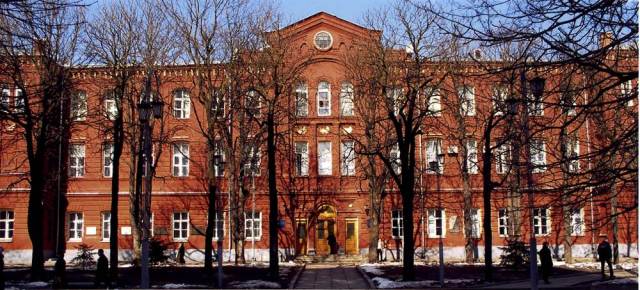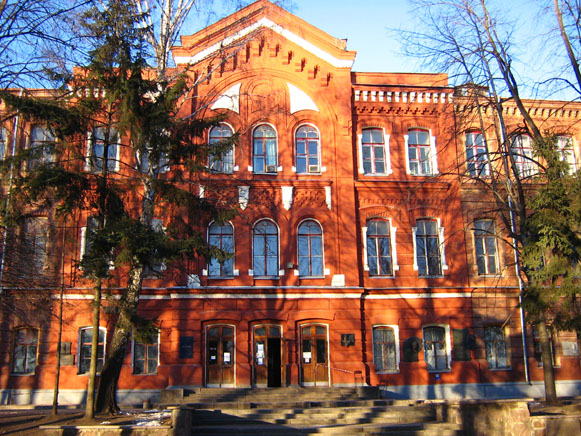Kharkiv Polytechnical Institute National Technical University
Kharkiv Polytechnical Institute National Technical University (Національний технічний університет «Харківський політехнічний інститут»; Natsionalnyi tekhnichnyi universytet ‘Kharkivskyi politekhnichnyi instytut’). An institution of higher education in Kharkiv under the auspicies of the Ministry of Education and Science of Ukraine; one of the leading technical universities in Ukraine. It was formed as Kharkiv Polytechnical Institute in 1929 out of the Kharkiv Technological Institute, which was founded in 1885 as Kharkiv Practical Technological Institute, the oldest higher technical school in Russian-ruled Ukraine. The first graduation took place in 1890, when 38 graduates received the degrees of a mechanical engineer and an engineer-chemist. In 1898 the institute was renamed Kharkiv Technological Institute (KhTI). Several of its students, including Lev Matsiievych, Oleksander Kovalenko, and Yurii Kollard, became the founding members of the Revolutionary Ukrainian party in 1900. A student technical society was created in 1902. In 1904 KhTI’s professorial council nominated chemist Dmitry Mendeleev as its honorary member. The first election of KhTI’s director took place in 1905. The same year KhTI began to publish the periodical Vesti Khar'kovskogo tekhnologicheskogo instituta. KhTI’s students and graduates took an active part in the Revolution of 1905 (for instance, mechanical engineer Oleksander Kovalenko played an important part in the uprising on the battleship Prince Potemkin). By 1917 KhTI trained 2,406 engineers.
In 1919 Kharkiv Women’s Polytechnical Institute was incorporated into KhTI. The faculty of construction (civil) engineering was added in 1920 on the initiative of architect Oleksii Beketov. The same year the Bolshevik government placed KhTI under the authority of a special commission created to speed up the training of mechanical engineers (with a proposed four-month course of study). A series of internal changes occurred in the 1920s. In 1921 the electrotechnical faculty was added, as well as the workers' faculty (with a two-, later three-year program for the workers of industrial enterprises). The aviation section was opened within the faculty of mechanics in 1923. With the increased political interference in the institute’s internal affairs, the student committee was replaced with the Soviet-style trade union (1925), the military training for students was introduced (1926), and the teaching of socioeconomic disciplines was gradually expanded. The student journal of science and technology Chervonyi tekhnoloh (The Red Technologist) was launched in 1928. To strengthen the links between technical education and industry, practical training for students at industrial enterprises became the norm in 1929. The same year KhTI was renamed Kharkiv Polytechnical Institute (KhPI). In 1930 it was replaced by five independent institutes—mechanical machine-building, electrotechnical, chemical-technological, civil engineering, and aviation—that at first remained on the same territory. The prominent physicist Lev Landau headed the department of theoretical physics at Kharkiv Mechanical Machine-building Institute in 1932–7. The Stalinist terror decimated Kharkiv’s higher schools and scientific research institutes, including those that emerged on the basis of KhPI. Among its most famous victims was the former rector of KhPI and later of Kharkiv Mechanical Machine-building Institute Helarii Slavin, professor of the Machine-building Institute Vasilii Tsvetkov, and professor of the Civil-engineering Institute Danylo Cherkes. During the Second World War some of the KhPI’s successor institutes were evacuated to the RSFSR. Aside from material losses sustained by Kharkiv technical institutes, 174 students, faculty members, and non-academic staff perished during the war.
Following the expulsion of the Nazis from Kharkiv, the Mechanical Machine-building institute and Electrotechnical Institute returned to the city in the fall of 1943, while the Chemical-technological Institute did so in January 1944. In 1949 Kharkiv Polytechnical Institute was restored on the basis of its former faculties that had existed prior to 1930. The enrollment reached 4,500 in 1949/50. The institute had 10 faculties: metallurgy; machine building; physics and engineering; automobile and tractor; inorganic matter technology; organic matter technology; silicate technologies; radio engineering; energy machine building; and electric. In 1951 KhPI was granted the right to award academic degrees of doctor and candidate of sciences. A number of new faculties were added during the 1950s and 1960s, including the correspondence faculty (1955), chemical machine-building (1960), automation and instrument-making (1960), public professions (1962), engineering and pedagogy (1963), transport machine-building (1965), and the advance training of the certified engineers of the Ministry of Electrotechnical Industry (1970). A few more faculties, scientific units, and teaching facilities were added in the 1970s and the 1980s: the faculty of applied physics and computational center (1972), the new 14-story study and laboratory building (1977), and the advance training institute (1987). KhTI had its branches in Luhansk (1945–60), Kirovohrad (1956–68), Rubizhne (1959–73), Lysychansk (opened 1959), Sumy (1966–90), and Kremenchuk (1974–97). Its enrollment reached 25,000 in the mid-1980s, which made it the third largest polytechnical institute in Soviet Ukraine (out the total of 7 polytechnical and 2 industrial institutes), behind only Kyiv Polytechnical Institute (31,000 students) and Lviv Polytechnical Institute (27,000 students).
In response to Mikhail Gorbachev’s perestroika and the resulting democratization of political regime in the USSR in the late 1980s, KhPI introduced student self-government (1988), added social sciences to its curriculum (institute of social sciences in 1988, followed by the chair of management and chair of business and controlling in 1991–2), and permitted some courses to be taught in the Ukrainian language (1989). The election of rectors on a democratic basis was introduced in 1990. In addition, individual faculties and departments received more autonomy to decide on their curricula and the recruitment of academic staff. In 1994 the institute was renamed Kharkiv State Technical University. In the 1990s, it gained a reputation as one of Ukraine’s leading technical universities in the fields of information technology and computer science. In 1997 its newly opened IBM learning center acquired an IBM ES-9000 model 421 with RAM of 512 MB, then the most powerful computer in Ukraine. It also became the first higher school in Ukraine to offer a joint major in economics and law (1997). New economic and technological majors were added, among them management of international economic relations, economic cybernetics, marketing, computer systems in medical and technical diagnostics, and biotechnical and medical aides and systems. Officially adopted by the university in 1997, the new teaching philosophy emphasized the ‘humanization’ of the training of engineers. By the end of the decade the university had 17 faculties and several engineering research and scientific research institutes.
In 2000 the university was granted the national university status and assumed its present name: Kharkiv Polytechnical Institute National Technical University (KhPINTU). The faculty of physics and engineering was transformed into the faculty of information science and management in 2001, followed by the opening of two new faculties in 2003: business and finances, and computer and information technologies. Sociology was added as a new major in the faculty of business and finances in 2009. In response to the needs of Kharkiv’s largest industrial enterprises, the chair of welding was opened in 2010. In 2010 KhPINTU was granted the status of a self-governed (autonomous) research national university. An agreement with the Microsoft Corporation allowed to streamline the training of computer engineers according to the international standards. The new scientific library was opened in 2014. In 2018, in the wake of a large-scale restructuring, 5 educational and scientific research institutes were created in place of more specialized faculties. In 2020 KhPINTU was designated as an authorized institution of higher learning for the aspiring students from the Donets Basin and Crimea. In the spring of 2022 its two educational buildings and six dormitories were damaged as a result of Russian shelling (with the damages assessed at 150 million hryvnas). On the night of 24 June 2022 the athletic center ‘Politekhnik,’ one of the main training grounds of Ukraine’s Olympic teams and a landmark of sports architecture, was severely damaged by Russian missiles.
KhPINTU has 9 educational and scientific research institutes—including power engineering, electronics and electromechanics; mechanical engineering and transport; engineering and physics; chemical technologies and engineering; economics, management, and international business; computer sciences and software engineering; computer and information technologies, and others. It also has a college of computer technologies in Kharkiv and a polytechnical college in Poltava, a branch faculty in Chernivtsi (since 1997), and training-consulting centers in Izium, Balakliia, and Poltava. The KhPINTU has 101 departments and over 100 laboratories. A graduate program and several upgrading programs are offered to postgraduates. The undergraduate program offers three educational levels: bachelor (4 years), professional (4 plus 1.5 years), and masters (4 plus 2 years). In 2021 the enrollment was over 20,000. The university’s scientific-technical library has 1.5 million volumes. KhPINTU has been consistently ranked among the country’s best institutions of higher learning. For instance, it was placed seventh in the independent academic ranking Top 200 Ukraine in 2021 and 24th in the 2021 Consolidated Ranking of all Ukrainian institutions of higher learning (more than 240 featured) according to the influential educational web portal Osvita.ua. In the same ranking, it was also placed the fifth best technical university in Ukraine and the fourth best higher school in eastern Ukraine. It has also appeared in major international academic rankings. For instance, The Times Higher Education World University Rankings 2022 placed KhPINTU in the group of 1001+ in physical sciences and engineering and 601+ in business and economics, while QS World University Rankings in 2020 listed it in the group of 601–50. Many noted scientists have worked at KhPINTU at different times of its history, including Lev Landau, Nikolai Beketov, Petr Budnikov, Anton Walter, Stepan Tymoshenko, Kyrylo Synelnykov, Heorhii Proskura, Vasyl Atroshchenko, Serhii Urazovsky, Anatolii Berezhnoi, and Anatolii Pidhorny. It publishes the newspaper Politekhnik (since 1951) and a dozen scientific journals, including Visnyk Natsional'noho universytetu “KhPI” in seven series (1961–); Elektrotekhnika i Elektromekhanika (2002–); Suchasni informatsiini systemy (6 vols, 2017–); Enerhozberezhennia, enerhetyka, enerhoaudyt (168 vols, 1997–); Dvyhuny vnutrishnioho zhoriannia (2002–); Lider. Elita. Suspil'stvo (2017–); and others.
BIBLIOGRAPHY
Natsional'nyi tekhnichnyi universytet “Kharkivs'kyi politekhnichnyi instytut.” Istoriia rozvytku. 1985–2010 (Kharkiv 2010)
KhPINTU’s official website: https://www.kpi.kharkov.ua/
Serhiy Bilenky
[This article was updated in 2022.]


